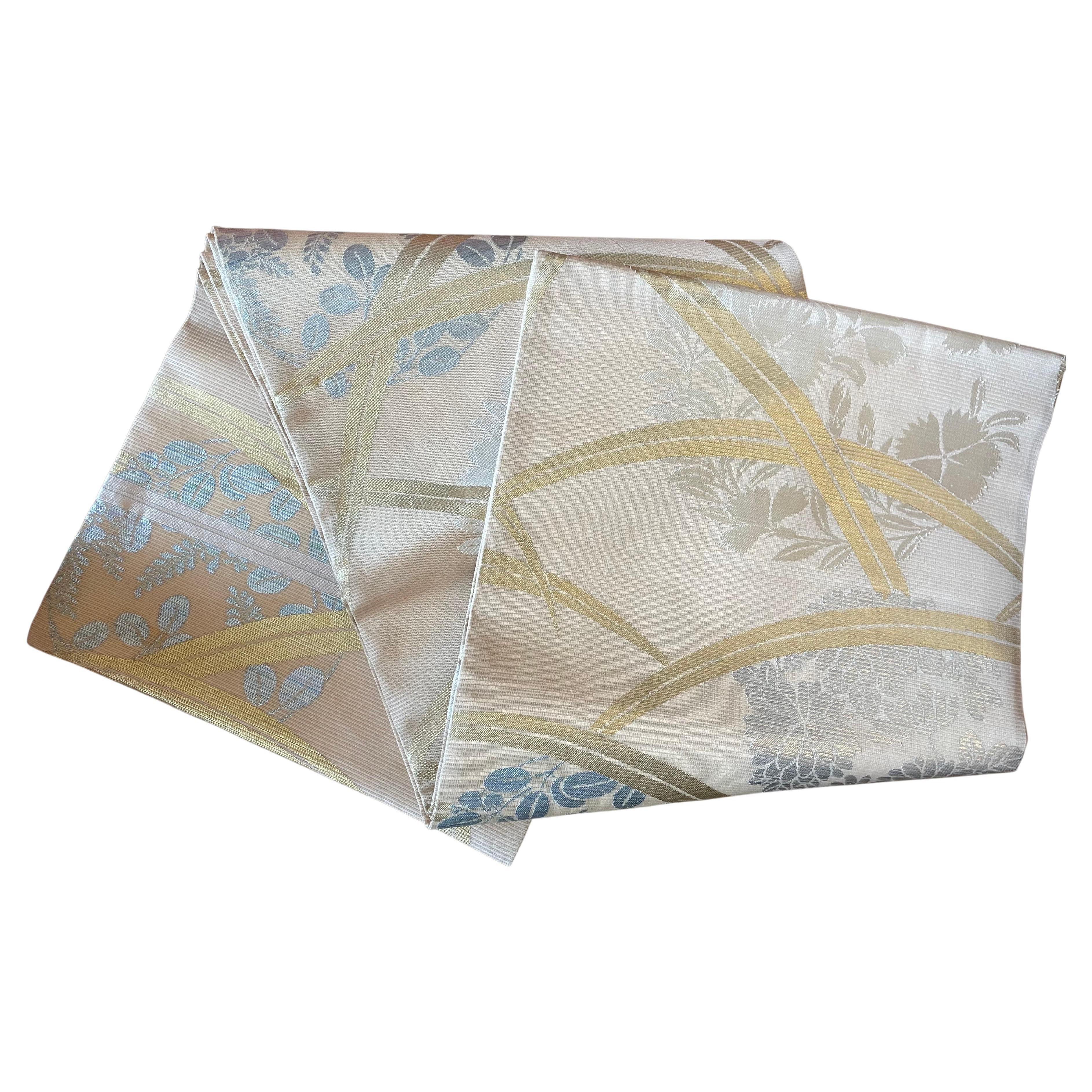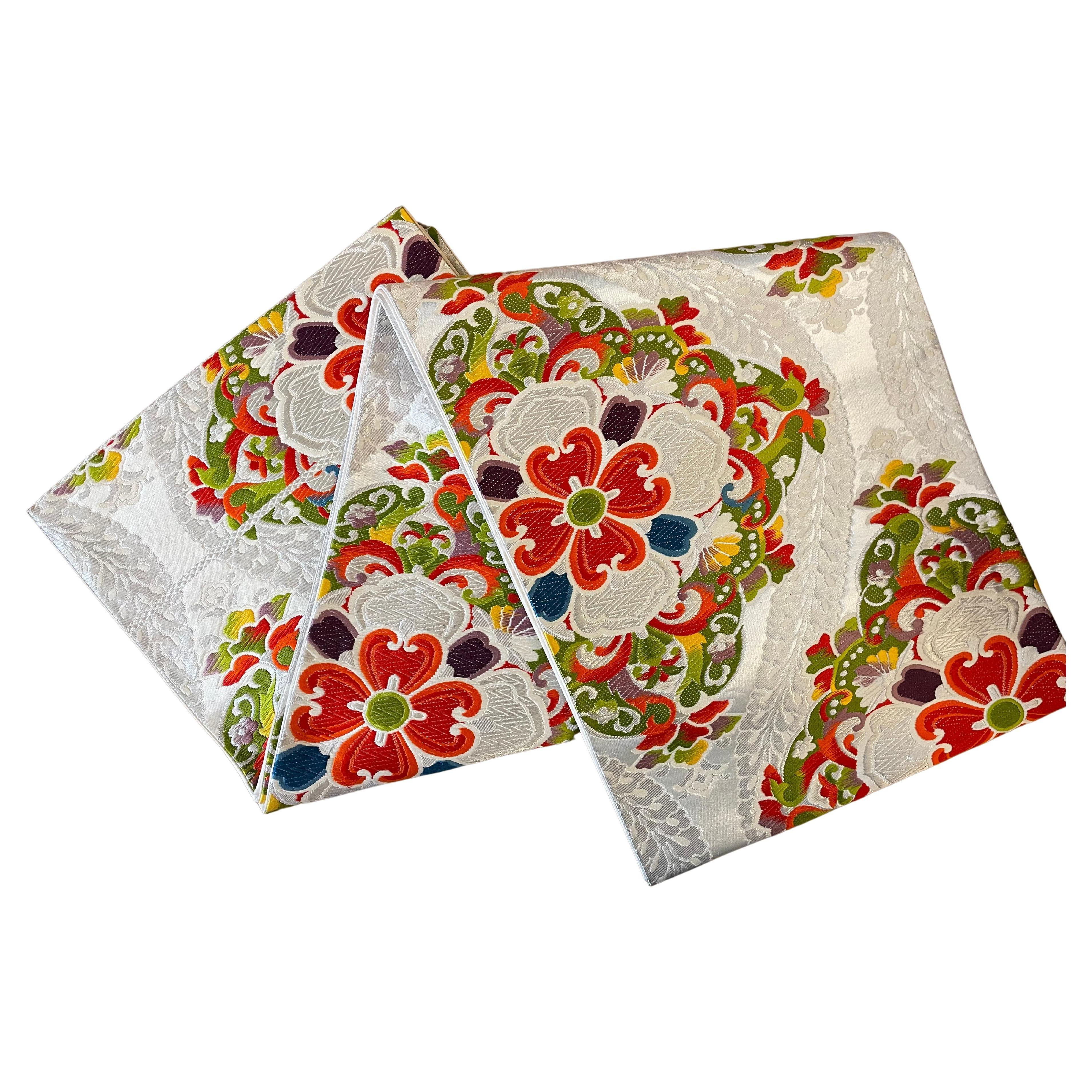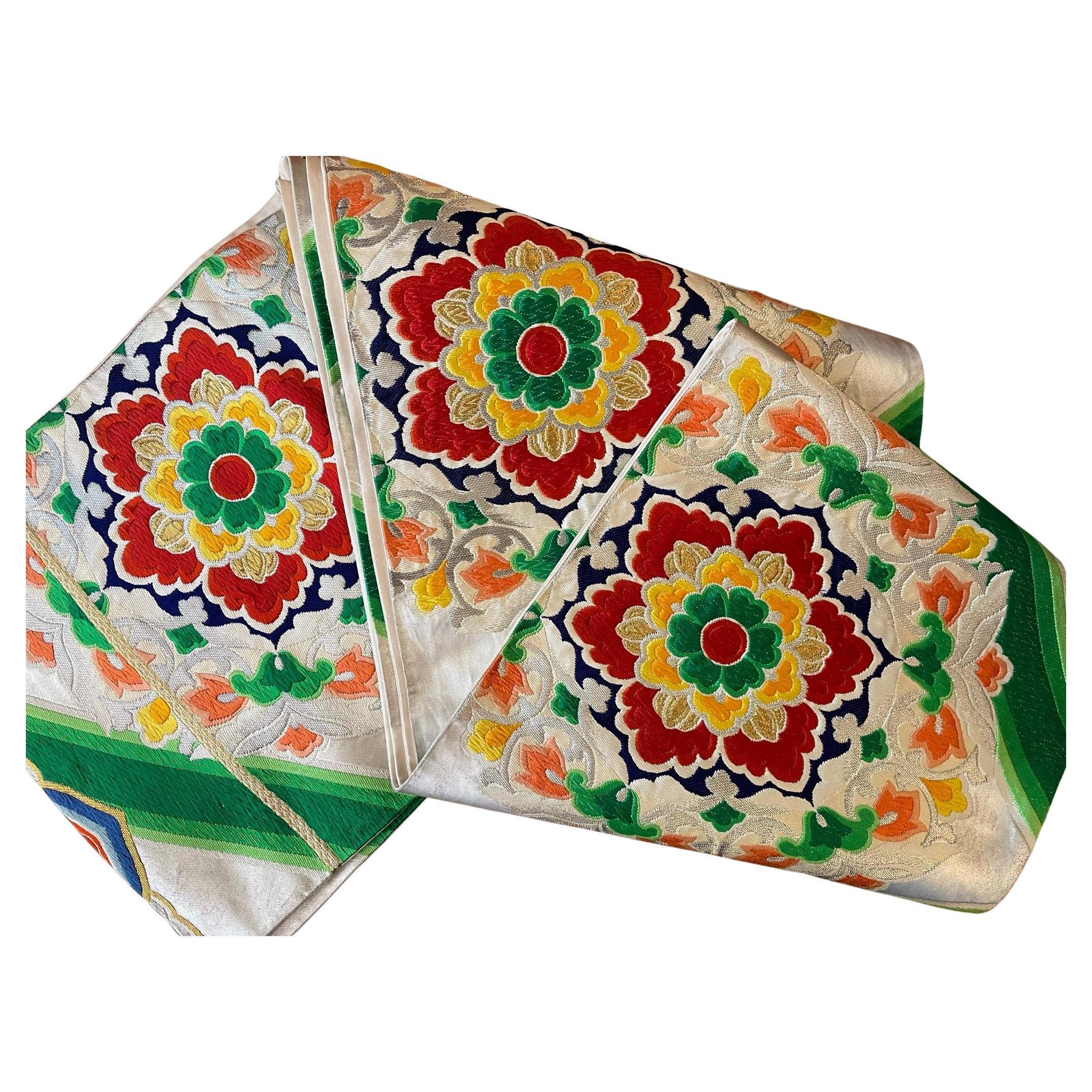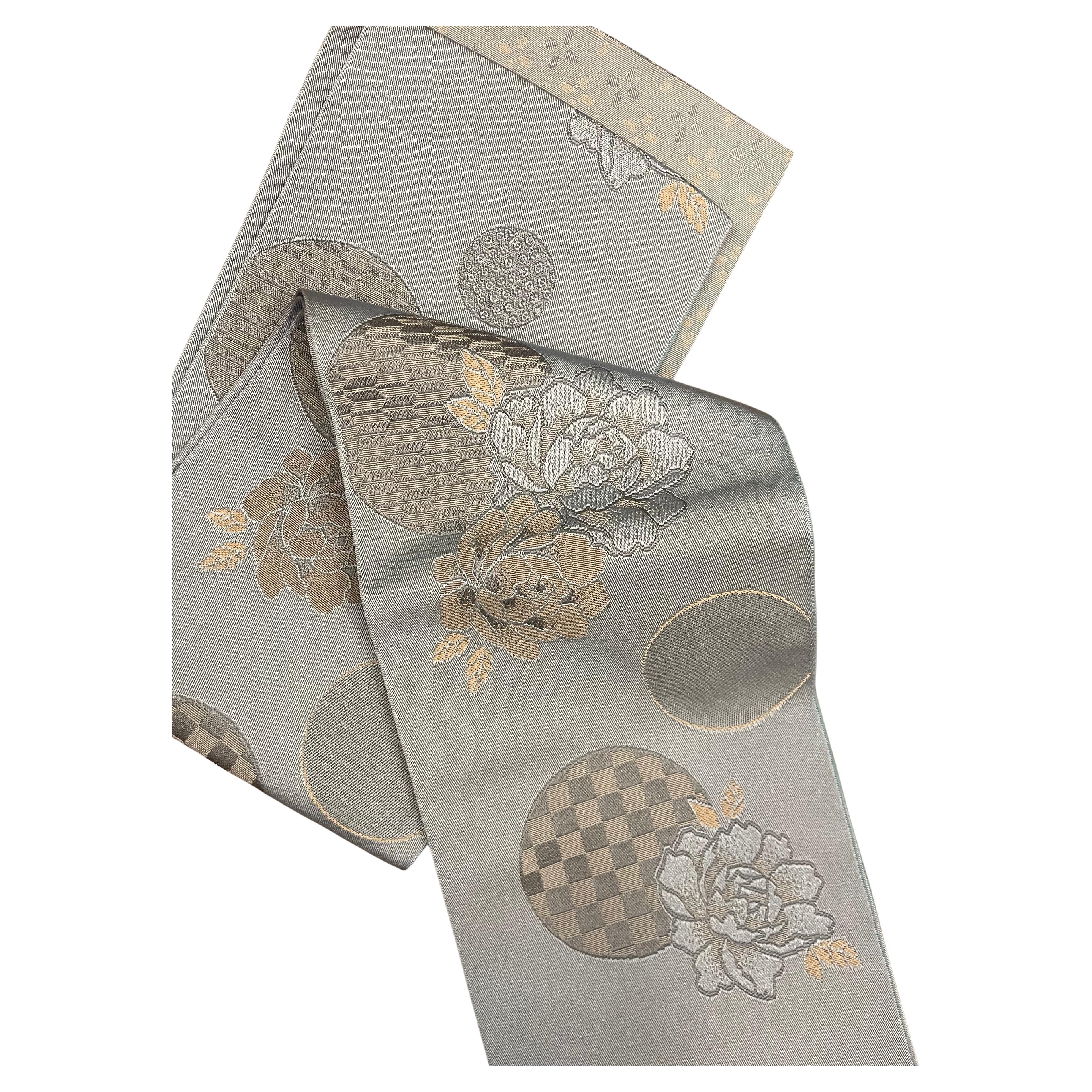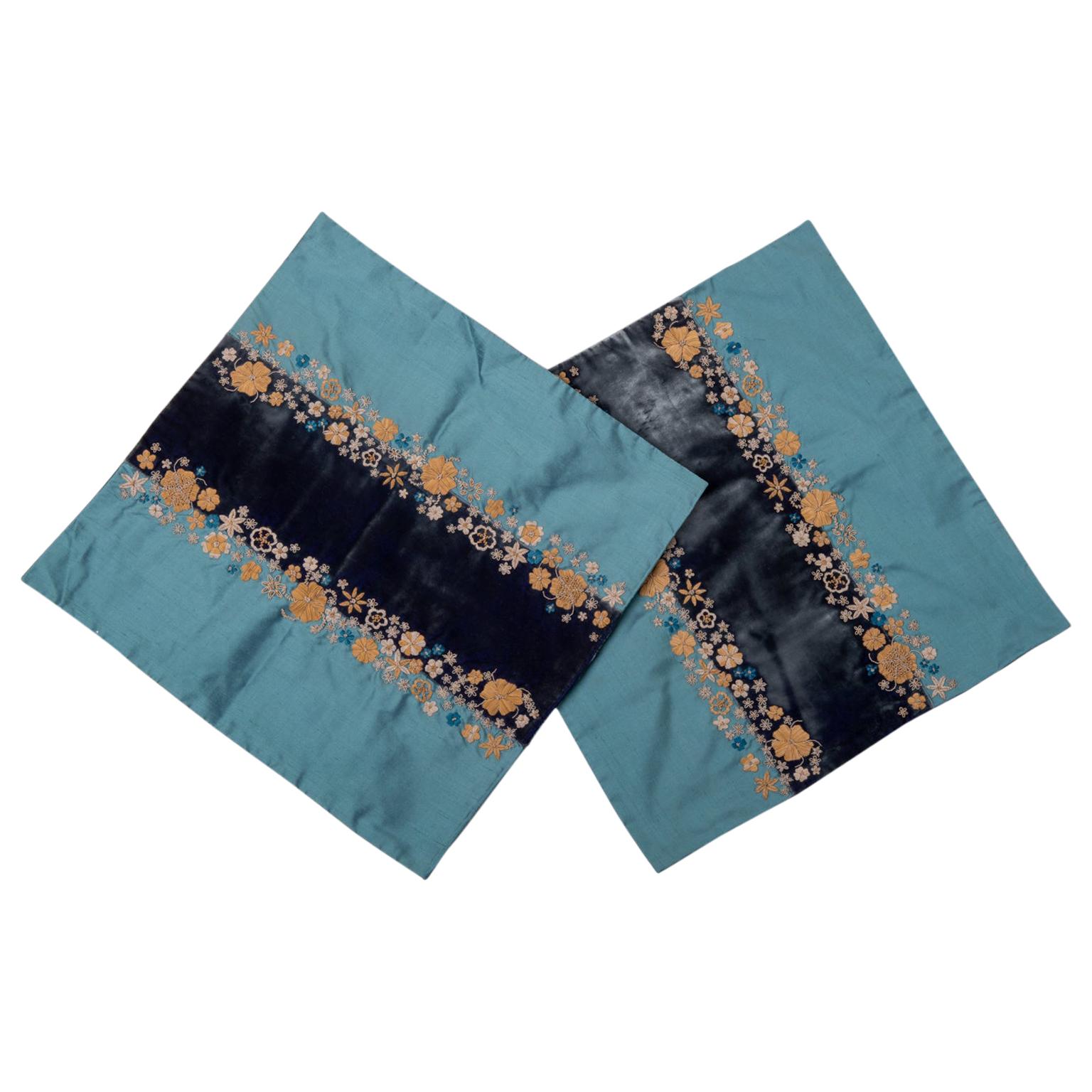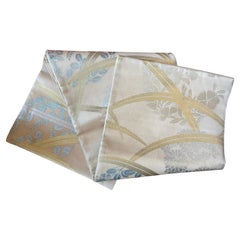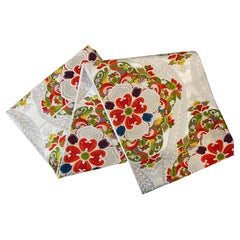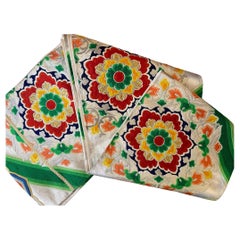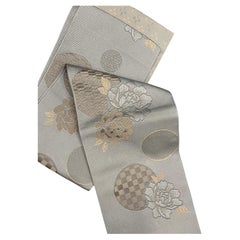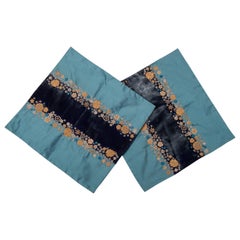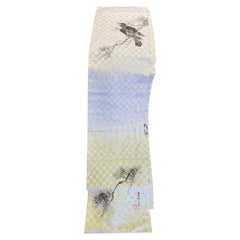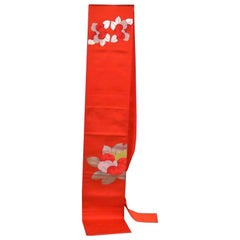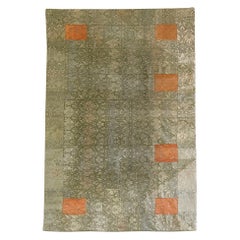Items Similar to Japanese Silk Obi Kimono Belt /Table runner 1970s Gold Two Cranes
Want more images or videos?
Request additional images or videos from the seller
1 of 10
Japanese Silk Obi Kimono Belt /Table runner 1970s Gold Two Cranes
$391.50
$489.3820% Off
£295.27
£369.0820% Off
€336
€42020% Off
CA$541.29
CA$676.6120% Off
A$606.33
A$757.9220% Off
CHF 318.47
CHF 398.0920% Off
MX$7,372.84
MX$9,216.0520% Off
NOK 4,032.86
NOK 5,041.0720% Off
SEK 3,828.27
SEK 4,785.3320% Off
DKK 2,557.85
DKK 3,197.3120% Off
About the Item
This is a Fukuro Obi made in Japan around 1970s.
It is made with Gold Silk (Kinshi) and it is in good condition.
Two cranes walking or flying together is the ultimate symbol of longevity. Since cranes fly in the clear blue sky above the dusty earth, they are also considered symbols of cleanliness and purity
Obi is a belt of varying size and shape worn with both traditional Japanese clothing like Kimono.Obi are categorised by their design, formality, material, and use, and can be made of a number of types of fabric, with heavy brocade weaves worn for formal occasions, and some lightweight silk obi worn for informal occasions.
Fukuro obi are slightly less formal than maru obi, despite being functionally the most formal variety of obi worn today. Fukuro obi are made from either a single double-width length of fabric with a seam down one edge, or from two lengths of fabric sewn together down each edge for fukuro obi made from two lengths of fabric, the fabric used for the backside may be cheaper and appear to be more plain.
Fukuro obi are roughly 30 centimetres (12 in) wide and 360 centimetres (11.8 ft) to 450 centimetres (14.8 ft) long. (Wikipedia)
Dimensions: this obi is 4m8cm (408cm) long and 30cm wide. On the front, it's all gold with motifs and in the middle, there is a part which has only gold fabric with no motif. On the back it's all white with no motifs.
- Dimensions:Height: 160.64 in (408 cm)Width: 11.82 in (30 cm)Depth: 0.4 in (1 cm)
- Style:Showa (Of the Period)
- Materials and Techniques:
- Place of Origin:
- Period:
- Date of Manufacture:1970
- Condition:There might be some little stains or some threads fraying.
- Seller Location:Paris, FR
- Reference Number:1stDibs: LU6325233680882
About the Seller
5.0
Vetted Professional Seller
Every seller passes strict standards for authenticity and reliability
1stDibs seller since 2022
50 sales on 1stDibs
- ShippingRetrieving quote...Shipping from: Paris, France
- Return Policy
Authenticity Guarantee
In the unlikely event there’s an issue with an item’s authenticity, contact us within 1 year for a full refund. DetailsMoney-Back Guarantee
If your item is not as described, is damaged in transit, or does not arrive, contact us within 7 days for a full refund. Details24-Hour Cancellation
You have a 24-hour grace period in which to reconsider your purchase, with no questions asked.Vetted Professional Sellers
Our world-class sellers must adhere to strict standards for service and quality, maintaining the integrity of our listings.Price-Match Guarantee
If you find that a seller listed the same item for a lower price elsewhere, we’ll match it.Trusted Global Delivery
Our best-in-class carrier network provides specialized shipping options worldwide, including custom delivery.More From This Seller
View AllAntique Silk Japanese Kimono Belt, 1970s
Located in Paris, FR
This is a Hitoe Obi made in Japan around 1970s.
Obi is a belt of varying size and shape worn with both traditional Japanese clothing like Kimono....
Category
Late 20th Century Japanese Showa Antiquities
Materials
Silk
Japanese Silk Kimono Belt Fukuro-Obi 1970s /Table Runner
Located in Paris, FR
This is a Fukuro Obi made in Japan around 1970s.
It is made with Silk and it is in good condition.
Obi is a belt of varying size and shape worn with both traditional Japanese clothing like Kimono.Obi are categorised by their design, formality, material, and use, and can be made of a number of types of fabric, with heavy brocade weaves worn for formal occasions, and some lightweight silk obi worn for informal occasions.
Fukuro obi are slightly less formal than maru obi...
Category
Late 20th Century Japanese Showa Antiquities
Materials
Silk
$314 Sale Price
25% Off
Japanese Antique Silk Kimono Belt, 1960s
Located in Paris, FR
This is a Fukuro Obi made in Japan around 1960s.
It is made with Silk and it is in good condition.
Obi is a belt of varying size and shape worn with both traditional Japanese clothing like Kimono.Obi are categorised by their design, formality, material, and use, and can be made of a number of types of fabric, with heavy brocade weaves worn for formal occasions, and some lightweight silk obi worn for informal occasions.
Fukuro obi are slightly less formal than maru obi...
Category
Late 20th Century Japanese Showa Antiquities
Materials
Silk
$354 Sale Price
20% Off
Japanese Half Kimono Belt Hanhaba Obi Sky Blue with Rose 1980s
Located in Paris, FR
This is a Japanese beautiful Kimono belt called 'Han haba obi'.
Both side are with motifs but different motifs. It is a belt for kimono but you can use as a table runner or wall deco...
Category
Vintage 1980s Japanese Showa Antiquities
Materials
Silk
$205 Sale Price
20% Off
Japanese Silk Obi Belt/ Table Runner 1960s Dark Red
Located in Paris, FR
This is a Fukuro Obi made in Japan around 1960s.
It is made with silk and it is in good condition.
Obi is a belt of varying size and shape worn with both traditional Japanese clothing like Kimono.Obi are categorised by their design, formality, material, and use, and can be made of a number of types of fabric, with heavy brocade weaves worn for formal occasions, and some lightweight silk obi worn for informal occasions.
Fukuro obi are slightly less formal than maru obi...
Category
Vintage 1960s Japanese Showa Decorative Art
Materials
Silk
Antique Japanese Kimono 'Uchikake' for Wedding, 1970s
Located in Paris, FR
This is a kimono called Uchikake which Japanese women wear for wedding ceremony.
It is said that the women wear the white uchikake for the reason of 'they can dyed in any color' and...
Category
Late 20th Century Japanese Showa Antiquities
Materials
Silk
You May Also Like
Silk Tissues Embroidered in Gold Tinsel, Pair
Located in Alessandria, Piemonte
B/1828 - Elegant pair of embroidered tissues to be used placed on a piece of furniture: You must admire closely, they are special, with silk, velvet and gold tinsel.
On request I ca...
Category
21st Century and Contemporary French Other Pillows and Throws
Materials
Silk
$335 Sale Price / set
20% Off
Japanese Signed Stamped Hand Drawn Silk Obi Sash Belt with Crow, Mid-1900
Located in Studio City, CA
A wonderful handmade vintage silk Obi sash/ belt featuring a rather unique hand-drawn scene with a crow and trees.
Signed and stamped by the artist...
Category
Mid-20th Century Japanese Showa Textiles
Materials
Silk
Vintage Orange Silk Japanese Obi with Gold and Silver Lamé and Brocade
Located in Topeka, KS
Handsome vintage Japanese obi in orange silk with gold and silver lamé and brocade flower and leaf design. It is in wonderful vintage condition. We have detected a small dark spot on...
Category
Mid-20th Century Japanese Japonisme Tapestries
Materials
Silk
Antique Japanese Brocade Monk's Robe Kesa Meiji Period
Located in Atlanta, GA
A Japanese Kesa (Monk's Vestment) made from thirteen columns of patchworks of shimmering woven brocades. The elaborate motifs feature repetitive elaborat...
Category
Antique Late 19th Century Japanese Meiji Textiles
Materials
Brocade, Silk
Japanese Obi with Landscape and Pavilion Motif – wall decoration, table runner
Located in Fukuoka, JP
A stunning Japanese obi textile from the Shōwa period, masterfully woven from silk with exquisite raden (mother-of-pearl inlay) detailing. This formal maru obi features a rich and in...
Category
20th Century Japanese Showa Textiles
Materials
Silk
Japanese Buddhist Monk Priest 7 Column Silk Brocade Kesa Ceremonial Temple Robe
Located in Studio City, CA
A wonderful, beautifully ornamented and somewhat rare fully intact Japanese Buddhist monk/ priest's Kesa ceremonial silk robe featuring various colorful birds in flight.
Kesa (which came from the Chinese word "kasaya") robes have been handmade/handstitched by monks/priests as an act of devotion as ceremonial robes for centuries in various Asian cultures (Japanese, Chinese, Korean, Vietnamese, Indian, etc.). The kesa is a rectangular garment designed to be worn over the left shoulder (see example image). The robes are made (often in a patchwork column pattern ranging from five, seven, nine or more pannels) specifically for fully ordained Buddhist monks, priests and nuns and are made from donations of exquisite textiles from wealthy patrons of Japanese Buddhist temples. The robes were used in daily ceremonies, temple gatherings, and private meditation.
Antique Kesa robes...
Category
Mid-20th Century Japanese Showa Textiles
Materials
Textile, Brocade, Silk
